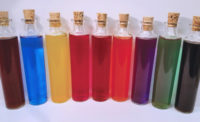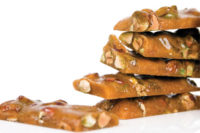Diversity is important — that’s a statement applicable both to people and to the food we eat. It’s part of what makes nuts and fruits ideal ingredients to add to confections.
“If one looks at the candy displays in retail establishments, there is a myriad of choices,” says Polly Owen, director, Hazelnut Marketing Board. “There seems to be an increased number of choices that include nuts in many forms and the packaging clearly hones in on the fact that the product includes nuts.”
The wide variety of options stems in part from the versatility of hazelnuts. They can be used in confections in virtually all available forms, including whole kernels, diced kernels of any size, paste, and butter. They also have a unique rich and buttery flavor that changes the flavor profile of the candy.
These traits, combined with the health benefits, make hazelnuts a choice ingredient for chocolatiers like Ferrero and Lindt.
And while the applications don’t seem new, says Owen, we are seeing more hazelnuts used in every form.
That’s good news for the hazelnut industry, which in Oregon is growing as evidenced by nearly 3,000 acres of trees being planted every year.
“A larger crop will ensure a consistent supply, which has been an issue for companies wanting to create new hazelnut products in the past,” says Owen.
Almonds, too, are available in a variety of forms, meaning there’s an option for every application. Their inclusion in candy also makes the confection more like a snack thanks to the added nutrition.
“Consumers consider certain kinds of candy and confections a type of snack,” says Jeff Smith, director of marketing, Blue Diamond Almonds, Global Ingredients Division. “So the increase in snacking generally, and the preference for nuts as a snack, is a trend that’s a win-win for both nuts and candy manufacturers.”
Almonds pack a powerful nutritional punch per oz. of protein (6 g.), fiber (4 g.), calcium (75 mg.), vitamin E (7.4 mg.), riboflavin (0.3 mg.), and niacin (1 mg.). They also contain 4 g. of fiber per oz. for energy and lasting satisfaction.
That all makes almonds perfect for adding a sought-after nutritional halo to confections.
“As an ingredient, chocolate was one of the most popular products that respondents frequently consumed with almonds, with 47 percent of those surveyed selecting that they eat almonds in chocolate several times a month or more,” says Harbinder Maan, senior marketing manager, Almond Board of California, quoting the 2015 Consumer AAU from Sterling-Rice Group. “When asked what other foods consumers would pair with almonds to make a ‘perfect snack,’ chocolate was the top pick, with 38 percent of consumers selecting it as their choice.”
Not only that, but several almond categories are experiencing rapid growth. Almond milk saw a 13 percent growth in volume, according to the 2015 Nielsen Analysis: Retail Product Movement, while nut and seed butters rose by 11.3 percent.
“Both almond milk and butter could be applied to a variety of formulations to fill specific needs such as dairy-free or gluten-free,” says Maan. “With the addition of flavored nut butters and milks, manufacturers can tap into these unique flavor profiles to increase the consumer appeal of trending products such as these by incorporating them into new chocolate and confectionery products.”
And at Blue Diamond Almonds, they’re working to create products that appeal to consumers’ increasingly sophisticated palates.
“We’re working with sweet flavors such as orange, honey and coconut and savory flavors such as bacon, wasabi and chili,” says Smith. “Candy manufacturers can now formulate new products with almonds that go beyond the traditional flavor combinations but still incorporate superior taste and textural qualities.”
But it’s not just nuts that can add to the flavor and texture of candy. Fruits are another set of ingredients that can dramatically change the way a confection is perceived.
Tart cherries, for example, are available year-round in a variety of forms such as dried, frozen, juice concentrate and canned, which makes them readily accessible for ingredient candymakers.
“From soothing arthritis symptoms and easing muscle pain after a workout to enhancing sleep, Montmorency tart cherries have been credited with an array of health advantages,” says Jeff Manning, chief marketing officer, the Cherry Marketing Institute. “In addition to their nutritional value, their sour flavor profile pairs beautifully with confections.”
Both cherries and blueberries have been used for chocolate and yogurt-covered confections. But the applications are expanding.
“Chocolate-covered or panned blueberries have been the domain of the small candy companies in the past ten years,” says Tom Payne, marketing consulting — food industry, U.S. Highbush Blueberry Council. “In 2014, all of a sudden, some of the top candy companies in the nation including Ghiradelli and Dove [Mars Chocolate North America] have launched new chocolate covered blueberry candies. They not only contain dried blueberries in the center, they feature beautiful blueberry art on the packages.”
And it’s not just in the United States. While the most popular products still combine blueberries and chocolates, Payne has seen some innovative blueberry candies in Asia and the Middle East. There’s Turkish Delight with blueberries (a gelled candy with dried and even fresh blueberries in the center), and the use of blueberries in a traditional Japanese candy called wagashi.
“In China, blueberries are mixed into candy fillings with sweet bean pastes to make innovative moon cakes which are served during the lunar new year festival,” says Payne.
In fact, he says, there’s a whole new generation of confectionery products being developed using blueberry paste in combination with healthy grains like quinoa and chia.
It all points to a growing desire to incorporate nutritional ingredients into candy.
“Confectionery brands are starting to champion natural ingredients, and self-denial is taking backstage as health and indulgence increasingly coexist in the mind of the consumer,” says Manning.
With nuts and fruits becoming more common additions to candy, it’ll be easier and easier to indulge in permissible, as well as, healthy snacking.









